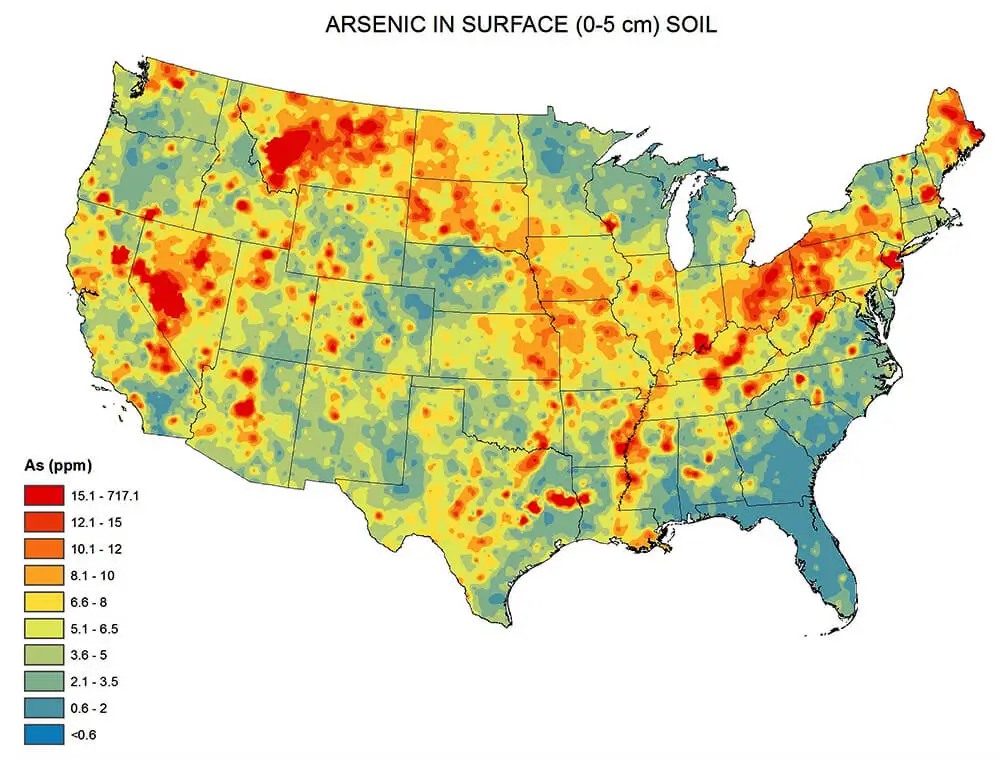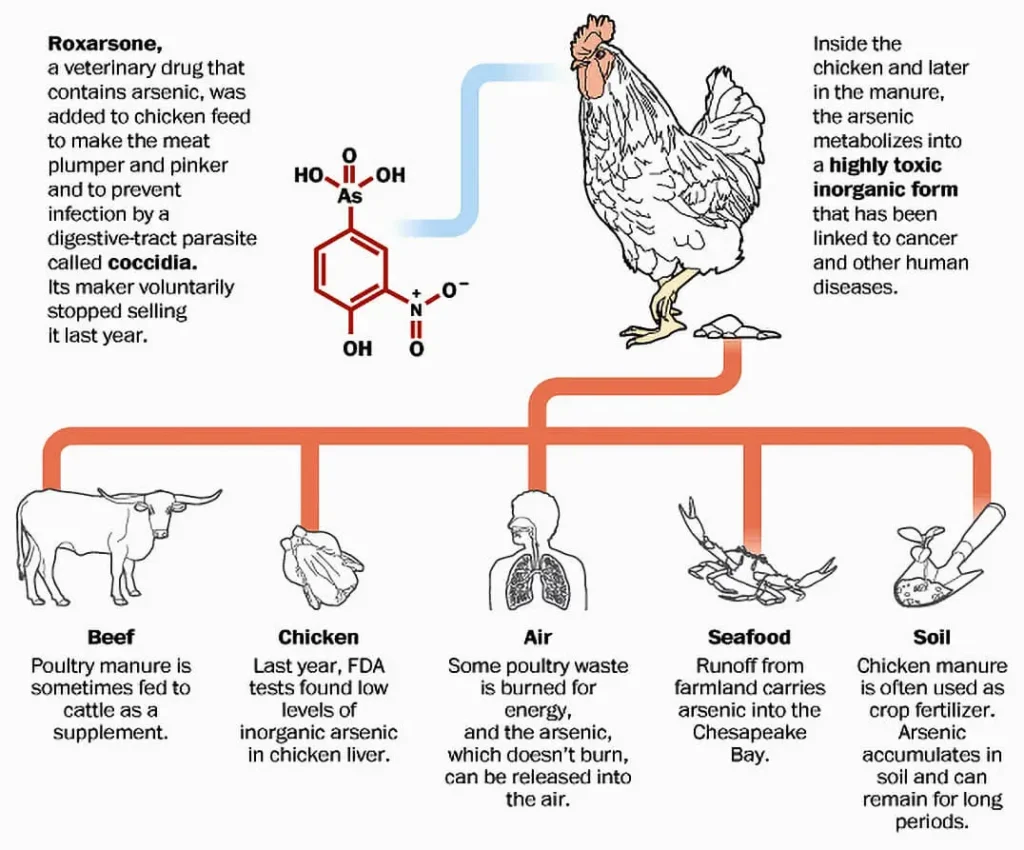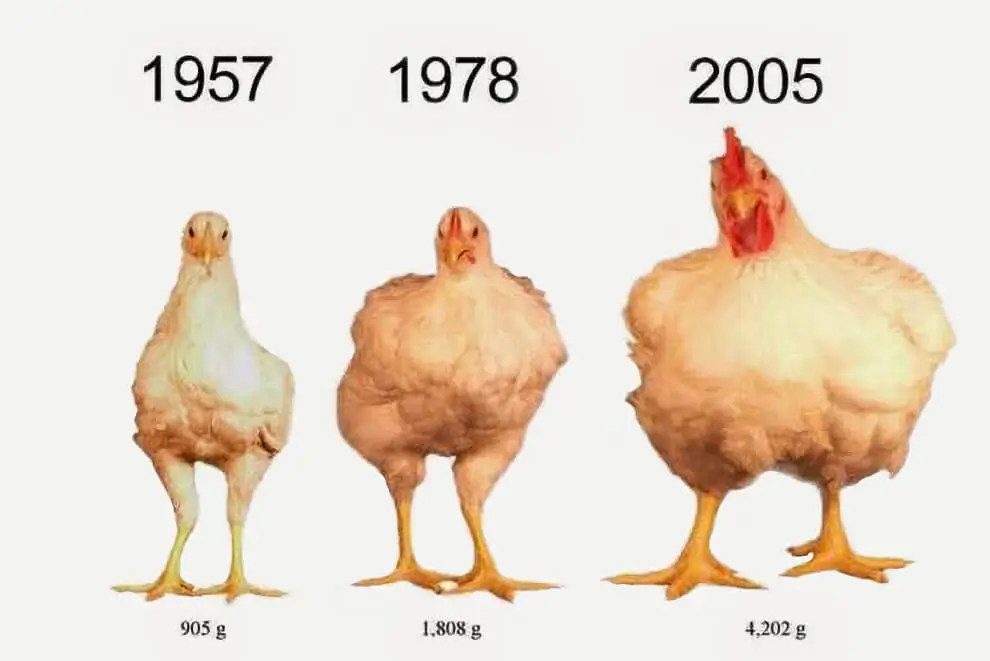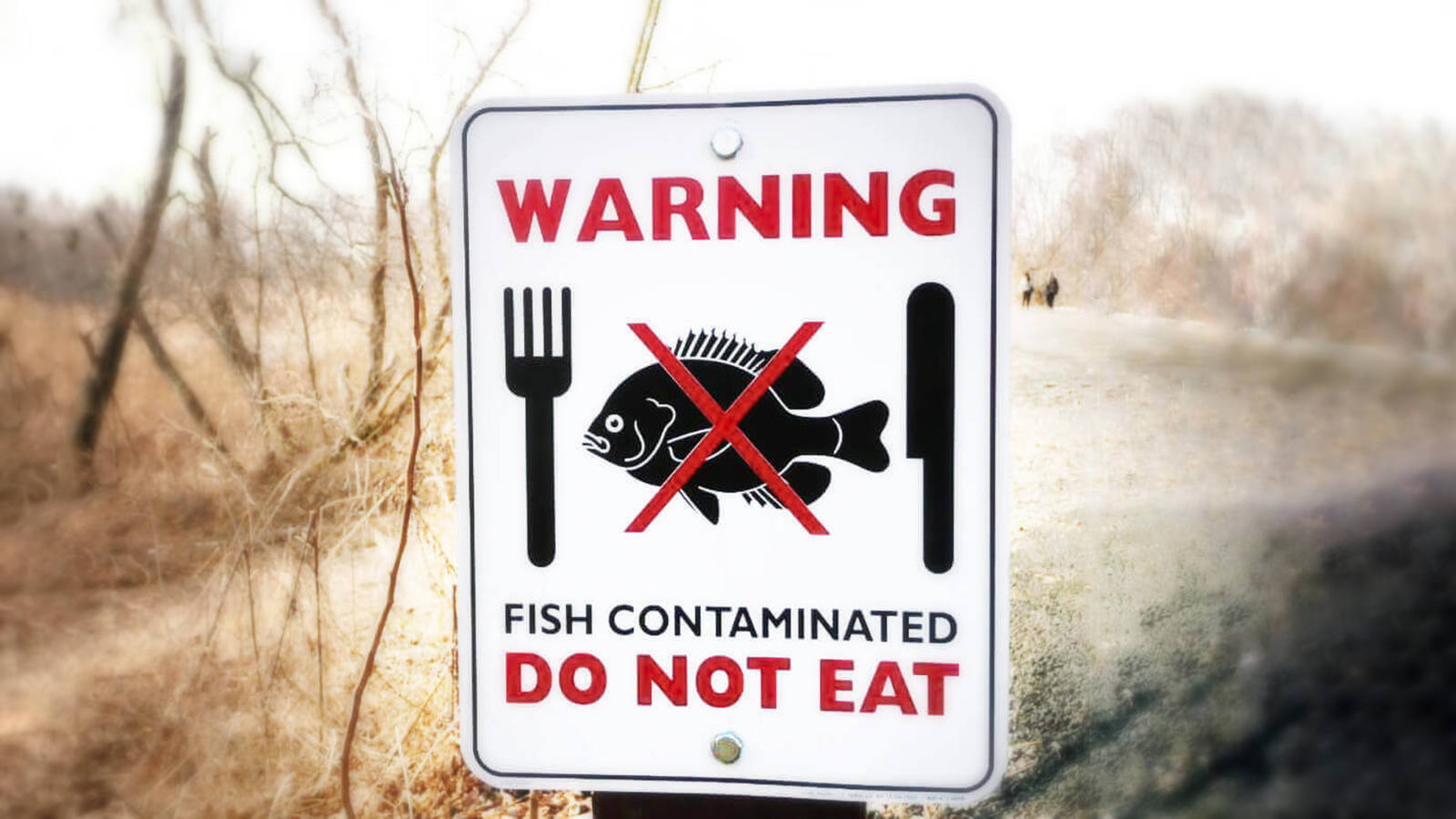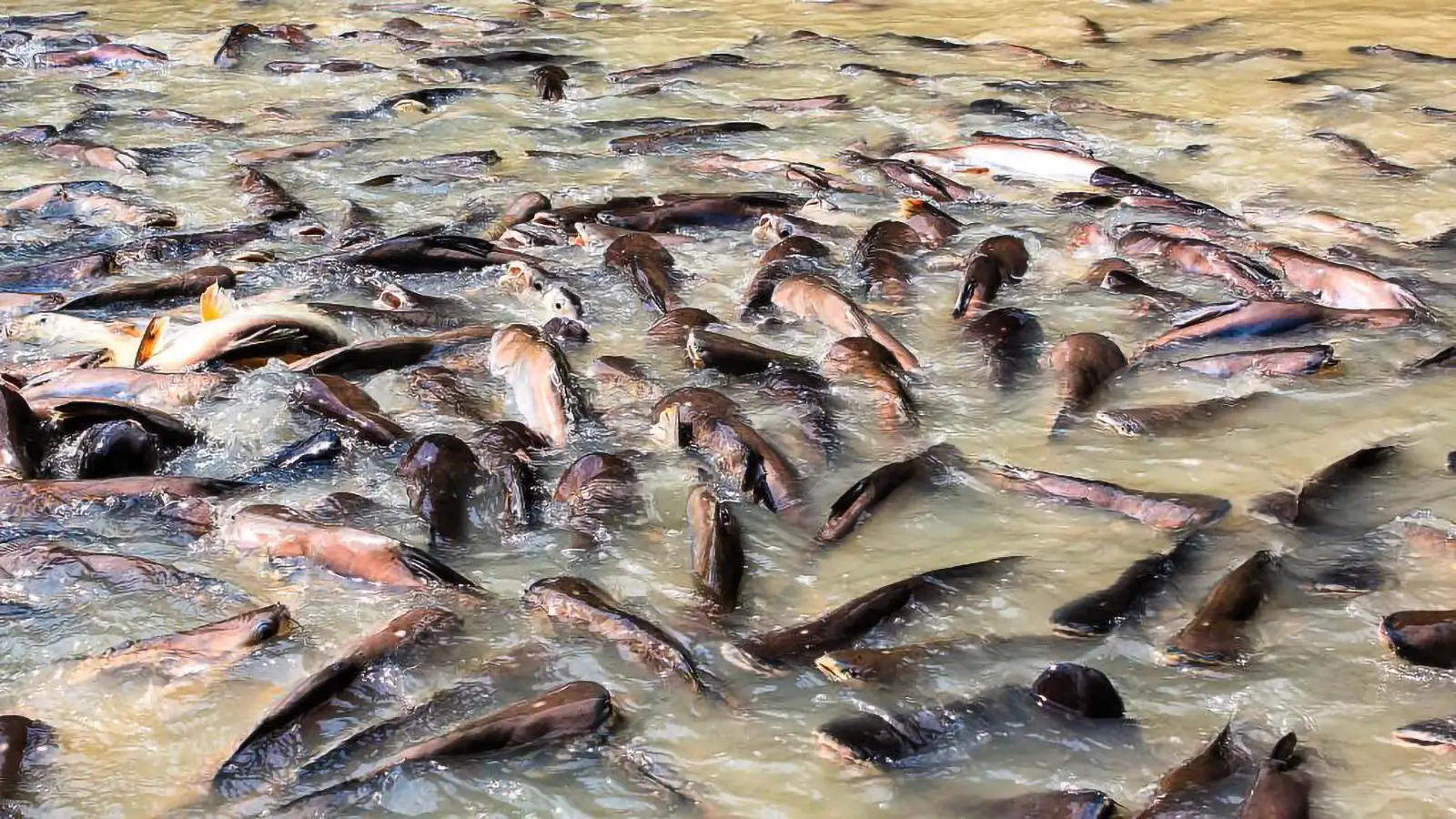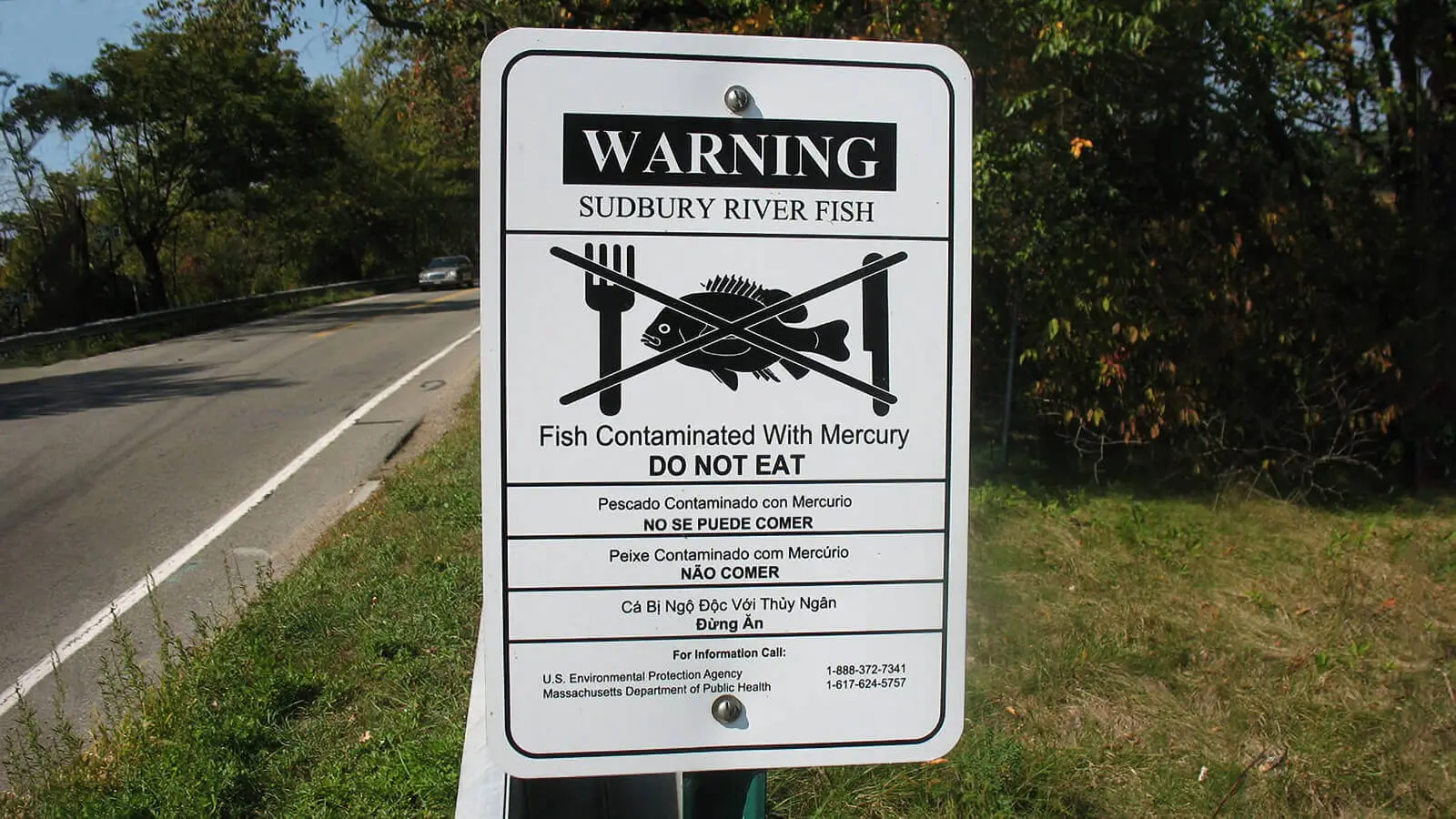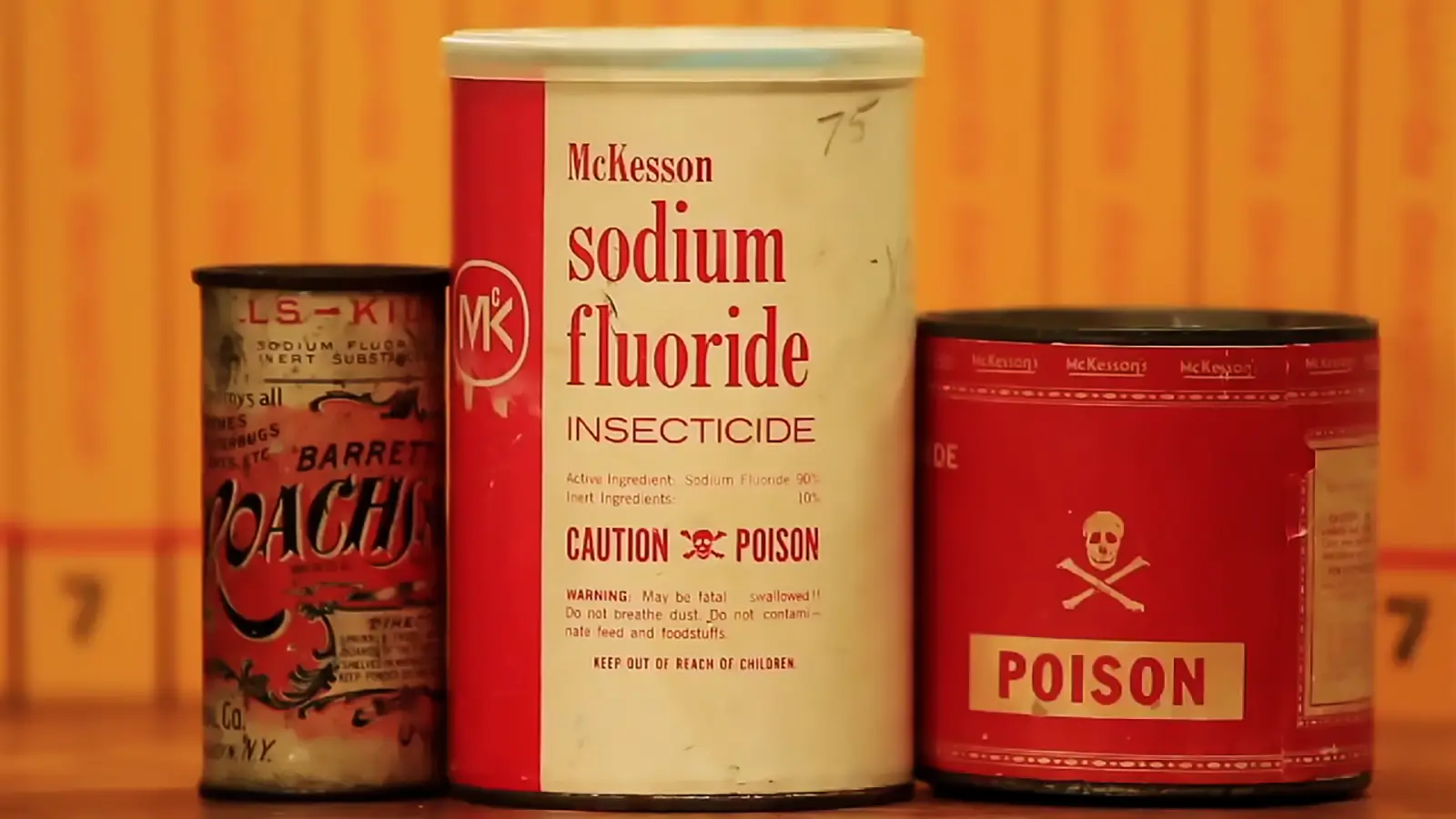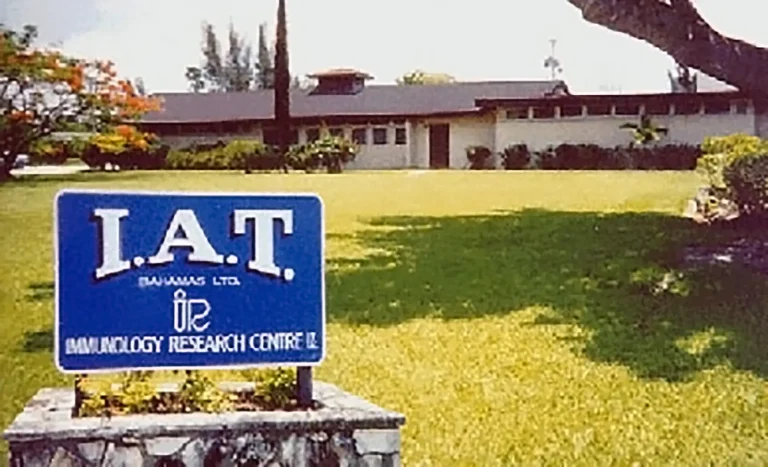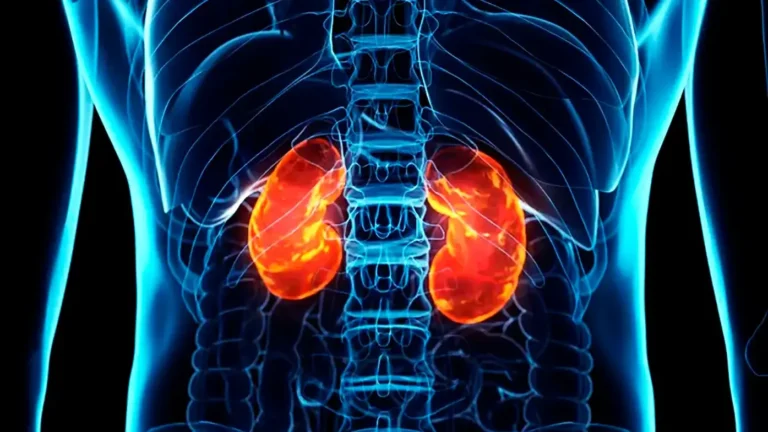In the US more than three-quarters of arsenic exposure comes from animal products and mostly from chicken than from beef, pork, hot dogs, eggs, and milk.
Milos Pokimica
Written By: Milos Pokimica
Medically Reviewed by: Dr. Xiùying Wáng, M.D.
Updated June 9, 2023Most of the arsenic exposure in the American diet does not come from rice because in the American diet rice is not a staple like in East Asia. In the US more than three-quarters of arsenic exposure comes from animal products and mostly from chicken.
The first mention of arsenic in history was at the court of the Roman Emperor Nero by the Greek physician Dioscorides in the first century. Arsenic is a hazardous substance because it lacks color, taste, or odor. It is abundant in nature and readily available to all classes of society. Because it can be mixed with drinks or food and leave no taste or smell it is an ideal substance for sinister uses. Symptoms of arsenic poisoning are also tough to detect because they mimic regular food poisoning and other common disorders. In large doses, it causes vomiting, diarrhea, violent abdominal cramping, and death. With chronic poisoning in small doses, there would be confusion, loss of strength, and paralysis. Eventually, arsenic trioxide (As2O3) known as white arsenic was commonly used to poison people with a lethal dose the size of a pea. Pope Alexander VI and his son, Cesare were, for example, well-known arsenic poisoners. Pope, Alexander VI appointed cardinals and with privileges and power granted by the church, cardinals were encouraged to do whatever it takes to increase their personal wealth. Then at some point, they were invited to have a meal with the Borgias resulting in the death of the cardinal. In that scenario by church law ownership of cardinal property reverted back to the church or in other words to Pope, Alexander VI, his executioner. With its colorful and long history, arsenic is not a substance that people want in their food.
If we look at arsenic pollution geographically, the U.S. is the most polluted place in the world. This is because arsenic is used in the farming industry for decades.
In modern poultry farms, there are too many chickens concentrated in a small amount of space. Most of them spend their entire life barely moving. In this type of condition chicken manure is a problem for the creation of infectious disease outbreaks. The typical chicken will produce roughly 90 pounds of manure. On big farms, there can be hundreds of thousands of chickens in one facility. The floor of these buildings is covered with feces, soybean, ethers, peanut, and rice hulls. To stop the infections and to prevent disease and promote growth the poultry industry has used organoarsenicals, such as a 3-nitro-4-hydroxyphenylarsonic acid (Roxarsone, ROX).
Due to continued soil accumulation, soil arsenic concentrations from long-term poultry litter applications can exceed safety level standards. These compounds would leach and contaminate underground waters that are in some cases even used for human consumption. What is much worse is that chicken litter is used for application to agricultural lands and for fertilizing fish ponds.
In the US around 90 percent of poultry litter filled with arsenic will be used in agricultural fields as fertilizer.
Then some of that arsenic will be absorbed by crops that grow on that arsenic-amended field. Poultry litter has also been used as feed for beef cattle as well. It is used as a starting material in the creation of mushroom compost. For years mushroom concentration of arsenic has rivaled rice. The latest study showed that now mushrooms average around half of the rice. The estimate was that around half a million pounds of pure arsenic were dumped in the environment every year in the U.S.
FDA monitors arsenic content in the diets of Americans for decades. The highest concentration is in farmed-raised fish at 1.14 ppm. Fish are fed with chicken manure. Even if you avoid fish, lower concentrations were found in most of the food items analyzed. Chicken has 0.08 ppm and rice has 0.16 ppm. Rice is the primary source of arsenic exposure in the non-seafood diet. FDA toxicologists argue that the average daily intake of arsenic poses no hazard to the consumer. I tend to disagree.
Arsenic pesticide usage in the U.S. has been common practice in cotton growing as well, so states like Mississippi and Arkansas have a higher level of pollution. Arsenic pesticides are now banned, but all of that pollution is still there so Californian rice, for example, has 41% lower levels of arsenic than Mississippi one. The concentration of arsenic in the soil can be at the point where it affects the rice plant itself. There is an arsenic toxicity disorder in rice called the straight head. The symptoms range from an increase of blank florets to complete grain failure. To deal whit this the industry created arsenic-resistant strains. Now rice can take much more than previously naturally possible without getting any problems. The only thing left to deal with this situation is for the industry now to create arsenic-resistant humans. The same story as with wine. Decades of arsenic pesticide use accumulated arsenic in the soil, so there is a constant, pervasive presence in American wine as well.
The situation today will be much worse if there wasn’t for one biostatistics student. It all started back in 2000 when a biostatistics student came to the USDA in search of a project for his master’s degree. What he was found is that the arsenic level in chicken was three times as in the other meats. Although this was an unexpected finding, it was soon explained to him that in the USA antibiotics containing arsenic are fed to the poultry to promote growth, improve pigmentation, and prevent diseases. FDA approved the first drug Roxarsone in 1944.
So while arsenic-containing drugs were in wide-scale use since the 1940’s the recognition of the exposure was only accrued after statistical analysis of the data. In other words, the FDA deliberately did nothing. The student did his master’s publication. After that, the study was published in 2004 and expanded in 2006.
Because the type of arsenic used is in organic form, not the toxic inorganic form made infamous in Arsenic and Old Lace the FDA approved these drugs as safe. This might seem logical to you, and I will like you to stop reading and think about this. How is it possible that FDA approves drugs for 70 years that are not safe? If arsenic used is in the nontoxic organic form then what is the problem, why would the FDA endanger the American people? They know what they are doing and who is manipulating who here? Poisoning children with 300 times of allowed arsenic concentrations for what? Profit. Without government approval, nothing can happen.
What happens, in this case, is this. When organic arsenic is cooked, cooking alters the arsenic profile into arsenite and arsenate. Also, microbes in the chicken manure alter the arsenic into inorganic form as well (Huang et al., 2014). It was shown that more than 96% of Roxarsone added to chicken feed was degraded and converted to arsenite, and other unknown As species. Roots of vegetables could absorb both forms of arsenate and arsenite, but only arsenite was transported up to shoots. This study proved that plants absorb the toxic inorganic As. Transport of arsenic goes like this: Roxarsone in feed › animals › animal manure › soil › crop.
Because of all of this “knowledge”, the Poison-Free Poultry Act of 2009 was introduced into Congress. Then again the Poison-Free Poultry Act of 2011, then again all of this was a just governmental lie. As a result, in 2013 different groups from the environmental movement, agriculture, food safety, and public health came together and filed joined lawsuit against the FDA forcing it to respond.
In 2015, to avoid public awareness of the entire corrupt system of the FDA, it was forced to withdraw approval for the last of the arsenic-containing drugs keeping this story as quiet as possible. The bad news for the industry is that without the Roxarsone the chicken meat will lose its appealing pink color. One more important thing to mention. Chicken manure is used for organic fertilizer production. It can be composted and converted to black gold. Arsenic was still there until 2016.
References:
- Huang, L., Yao, L., He, Z., Zhou, C., Li, G., Yang, B., & Deng, X. (2014). Roxarsone and its metabolites in chicken manure significantly enhance the uptake of As species by vegetables. Chemosphere, 100, 57–62. https://doi.org/10.1016/j.chemosphere.2013.12.074
Related Posts
Do you have any questions about nutrition and health?
I would love to hear from you and answer them in my next post. I appreciate your input and opinion and I look forward to hearing from you soon. I also invite you to follow us on Facebook, Instagram, and Pinterest for more diet, nutrition, and health content. You can leave a comment there and connect with other health enthusiasts, share your tips and experiences, and get support and encouragement from our team and community.
I hope that this post was informative and enjoyable for you and that you are prepared to apply the insights you learned. If you found this post helpful, please share it with your friends and family who might also benefit from it. You never know who might need some guidance and support on their health journey.
– You Might Also Like –

Learn About Nutrition
Milos Pokimica is a doctor of natural medicine, clinical nutritionist, medical health and nutrition writer, and nutritional science advisor. Author of the book series Go Vegan? Review of Science, he also operates the natural health website GoVeganWay.com
Medical Disclaimer
GoVeganWay.com brings you reviews of the latest nutrition and health-related research. The information provided represents the personal opinion of the author and is not intended nor implied to be a substitute for professional medical advice, diagnosis, or treatment. The information provided is for informational purposes only and is not intended to serve as a substitute for the consultation, diagnosis, and/or medical treatment of a qualified physician or healthcare provider.NEVER DISREGARD PROFESSIONAL MEDICAL ADVICE OR DELAY SEEKING MEDICAL TREATMENT BECAUSE OF SOMETHING YOU HAVE READ ON OR ACCESSED THROUGH GoVeganWay.com
NEVER APPLY ANY LIFESTYLE CHANGES OR ANY CHANGES AT ALL AS A CONSEQUENCE OF SOMETHING YOU HAVE READ IN GoVeganWay.com BEFORE CONSULTING LICENCED MEDICAL PRACTITIONER.
In the event of a medical emergency, call a doctor or 911 immediately. GoVeganWay.com does not recommend or endorse any specific groups, organizations, tests, physicians, products, procedures, opinions, or other information that may be mentioned inside.
Editor Picks –
Milos Pokimica is a doctor of natural medicine, clinical nutritionist, medical health and nutrition writer, and nutritional science advisor. Author of the book series Go Vegan? Review of Science, he also operates the natural health website GoVeganWay.com
Latest Articles –
Plant Based News
-
‘I Tried TikTok’s Viral Vegan High-Protein Breakfasts’
on June 14, 2025
-
Epic Veggie Sandwich
on June 14, 2025
-
Vegan Cinnamon Slice
on June 13, 2025
-
The Secret To Vegan Meal Prep That Actually Works
on June 13, 2025
-
One-Dish Chickpea ‘Tuna’ Salad
on June 12, 2025
-
How To Build A Healthy Plant-Based Meal Plan That Lasts
on June 12, 2025
-
Garlic And Pepper Tofu
on June 11, 2025
Top Health News — ScienceDaily
- CRISPR-edited stem cells reveal hidden causes of autismon June 14, 2025
A team at Kobe University has created a game-changing resource for autism research: 63 mouse embryonic stem cell lines, each carrying a genetic mutation strongly associated with the disorder. By pairing classic stem cell manipulation with precise CRISPR gene editing, they ve built a standardized platform that mirrors autism-linked genetic conditions in mice. These models not only replicate autism-related traits but also expose key dysfunctions, like the brain s inability to clean up faulty […]
- Sugar shield restored: The breakthrough reversing brain aging and memory losson June 13, 2025
A protective sugar coating on brain blood vessels, once thought to be insignificant, turns out to play a vital role in preventing cognitive decline. Restoring this layer reversed damage and memory loss in aging brains, offering a fresh approach to treating neurodegenerative diseases.
- Invisible ID: How a single breath could reveal your health—and your identityon June 13, 2025
Scientists have discovered that your breathing pattern is as unique as a fingerprint and it may reveal more than just your identity. Using a 24-hour wearable device, researchers achieved nearly 97% accuracy in identifying people based solely on how they breathe through their nose. Even more intriguingly, these respiratory signatures correlated with traits like anxiety levels, sleep cycles, and body mass index. The findings suggest that breathing isn t just a passive process it might actively […]
- Sleep-in science: How 2 extra weekend hours can calm teen anxietyon June 13, 2025
Teens might finally have a good reason to sleep in on weekends within limits. A new study reveals that teenagers who get up to two extra hours of sleep on weekends show fewer anxiety symptoms than those who don t. But go beyond that sweet spot, and symptoms can actually increase.
- Johns Hopkins blood test detects tumor dna three years earlyon June 13, 2025
Researchers at Johns Hopkins found that fragments of tumor DNA can appear in the bloodstream up to three years before a cancer diagnosis, offering a potentially revolutionary window for early detection and treatment.
- Running rewires your brain cells—igniting memory-saving genes against alzheimer’son June 13, 2025
Scientists have uncovered how exercise directly influences brain health in Alzheimer’s disease by pinpointing the exact brain cells affected. Using cutting-edge RNA sequencing and mouse models, researchers identified changes in specific cells like microglia and a novel type of astrocyte after exercise.
- Guest molecules ride perfect waves in dna droplets—A breakthrough for synthetic biologyon June 13, 2025
Scientists have uncovered a previously unknown type of molecular motion inside DNA-based droplets: instead of spreading randomly, guest molecules advance in an organized wave. This surprising discovery opens the door to understanding how cells might organize internal processes without membranes. Using customizable DNA condensates as experimental models, the team showed how molecular waves emerge through precise DNA interactions. These insights could not only transform our grasp of cellular […]
PubMed, #vegan-diet –
- Protein Intake and Protein Quality Patterns in New Zealand Vegan Diets: An Observational Analysis Using Dynamic Time Warpingon June 13, 2025
Background/Objectives: Inadequate intake of indispensable amino acids (IAAs) is a significant challenge in vegan diets. Since IAAs are not produced or stored over long durations in the human body, regular and balanced dietary protein consumption throughout the day is essential for metabolic function. The objective of this study is to investigate the variation in protein and IAA intake across 24 h among New Zealand vegans with time-series clustering, using Dynamic Time Warping (DTW). Methods:…
- Diet and nutrition in cardiovascular disease prevention: a scientific statement of the European Association of Preventive Cardiology and the Association of Cardiovascular Nursing & Allied Professions…on June 12, 2025
What we eat is a cornerstone of cardiovascular disease (CVD) prevention, but health professionals may not have a clear understanding of the current evidence-based research to underpin eating habits and recommendations. This study aims to appraise existing evidence-based research on the importance of diet on CVD risk biomarkers, specifically, the effects of dietary patterns, specific foods, and constituents including vitamins/minerals and plant-derived bioactive compounds on CVD risk. […]
- Synergistic Effects of Steam Impinged Microwave-Vacuum Blanching on the Textural Behavior of Vegan Pattieson June 11, 2025
The present study was carried out to understand the effect of the process variables of the combined microwave-vacuum-steam blanching process on the textural behavior of vegan patties. This novel blanching technique was systematically evaluated to optimize parameters, including microwave power density (3.8 W/g), steam duration (3 s), pea-to-potato mash ratio (0.252), patty thickness (0.866 cm), and microwave irradiation time (133 s). Fourier transform infrared (FTIR) spectroscopy was employed […]
- Plant-based diet and risk of osteoporosis: A systematic review and meta-analysison June 10, 2025
CONCLUSIONS: This systematic review and meta-analysis indicate that adherence to plant-based diet may be associated with an elevated risk of osteoporosis, particularly at the lumbar spine, among individuals following a vegan diet or following a plant-based diet for ≥10 y. However, the heterogeneity observed across studies highlights the need for well-designed prospective studies in future, to clarify this relationship.
- Plant-based diets for sustainability and health – but are we ignoring vital micronutrients?on June 9, 2025
Plant-based diets, with limited quantities of animal foods, are increasingly promoted for sustainability and health. In many countries, animal-source foods provide the majority of several micronutrients at a population level; in the UK, milk and dairy products contribute around one third of total calcium, vitamin B(12) and iodine intake in adults. Recommendations for a predominantly plant-based diet may have the unintended consequence of reducing intake of micronutrients, particularly in […]
Random Posts –
Featured Posts –

Latest from PubMed, #plant-based diet –
- Association Between Dietary Protein Sources and Nutrient Intake in the Diet of Canadian Childrenby Hrvoje Fabek on June 13, 2025
CONCLUSIONS: An approximate 3:1 ratio of animal-to-plant protein sources may represent an optimal balance for supporting nutrient intake and improving macronutrient profiles in the diets of Canadian children.
- Pre-Conception Physical Activity and the Risk of Gestational Diabetes Mellitus: Findings from the BORN 2020 Studyby Antigoni Tranidou on June 13, 2025
Background/Objectives: Pre-conception health behaviors may influence the risk of gestational diabetes mellitus (GDM), but evidence on the joint effects of physical activity (PA) and dietary patterns remains limited. This study investigated the associations between pre-conception PA and GDM risk and explored their interaction with adherence to a Mediterranean diet (MD). Methods: This analysis used data from the BORN2020 cohort, which included pregnant women in Greece (2020-2022). […]
- Adherence to the Planetary Health Diet and Its Association with Diet Quality and Environmental Outcomes in Croatian University Students: A Cross-Sectional Studyby Gordana Kenđel Jovanović on June 13, 2025
CONCLUSIONS: This study highlights the moderate sustainability of students’ diets, with significant associations between diet quality and environmental impacts. University settings present key opportunities for the promotion of sustainable, health-oriented eating behaviors among young adults.
- Exploring the Benefits of Extra Virgin Olive Oil on Cardiovascular Health Enhancement and Disease Prevention: A Systematic Reviewby Sara Ussia on June 13, 2025
Introduction: Olive oil’s health benefits are widely known and extensively documented; its advantages are widespread, covering numerous areas of human health. Clinical and experimental data indicate that a Mediterranean Diet (MedDiet) with Extra Virgin Olive Oil (EVOO) lowers the risk of illnesses associated with oxidative stress, chronic inflammation, and weakened immunity, including cancer and cardiovascular disease (CVD). The European Food Safety Authority (EFSA) confirms that olive oil’s…
- Dietary Interventions and Oral Nutritional Supplementation in Inflammatory Bowel Disease: Current Evidence and Future Directionsby Brigida Barberio on June 13, 2025
CONCLUSIONS: Dietary interventions and ONS represent valuable therapeutic tools in IBD management. Future research should prioritize standardized, well-powered clinical trials and personalized nutritional approaches to better define their role within integrated care pathways.
- Diet in Knee Osteoarthritis-Myths and Factsby Natalia Kasprzyk on June 13, 2025
Knee osteoarthritis (OA) is a common degenerative joint disease affecting global health. Its increasing prevalence, particularly among aging populations, remains a leading cause of disability. Besides conventional pharmacological and surgical treatments, dietary interventions are promising strategies to alleviate OA symptoms and progression. Unfortunately, scientific evidence does not support many commonly used, misleading ideas about nutrition in knee OA. Recent data highlight the […]


